

New tool offers practitioners the opportunity to measure resilience and report impact. Implicit in all development work is the quest for impact.

Positively influencing livelihoods, landscapes and ecosystems is the goal of our work. Indicators and a Monitoring Framework for Sustainable Development Goals: Launching a data revolution for the SDGs. Climate Action Tracker. Climate change. Key issues on climate change. Germany 2050 - A Greenhouse Gas-Neutral Country. Key issues on climate change. United Cities and Local Governments. Mayor de Blasio Releases One New York: The Plan for a Strong and Just City. April 22, 2015 OneNYC establishes bold goals and specific targets for a strong, sustainable, resilient, and equitable city – 800,000 people out of poverty by 2025, Zero Waste, eliminating long-term displacement after future shock events, and much more Mayor de Blasio: Environmental and Economic Sustainability Must Go Hand in Hand – and OneNYC is the Blueprint NEW YORK—The de Blasio administration announced today the release of “One New York: The Plan for a Strong and Just City,” a comprehensive plan for a sustainable and resilient city for all New Yorkers that addresses the profound social, economic, and environmental challenges ahead.
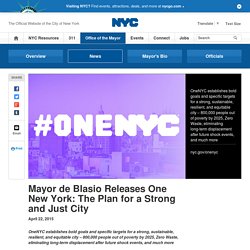
OneNYC builds on prior long-term sustainability plans for New York City, expanding on the critical targets established under previous plans, as well as on the work of the de Blasio administration over the last 16 months. “Environmental and economic sustainability must go hand in hand – and OneNYC is the blueprint to ensure they do,” said Mayor de Blasio. Balancing the dimensions in the SDGs FINAL. Weaving_ecosystem_services_into_impact_assessment_technical_appendix.pdf. Why it pays to be an active city. The same elements that make a city a great place for physical activity also make it more competitive for investment and job creation.
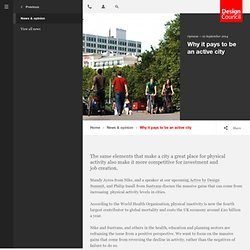
Mandy Ayres from Nike, and a speaker at our upcoming Active by Design Summit, and Philip Insall from Sustrans discuss the massive gains that can come from increasing physical activity levels in cities. According to the World Health Organisation, physical inactivity is now the fourth largest contributor to global mortality and costs the UK economy around £20 billion a year.
Nike and Sustrans, and others in the health, education and planning sectors are reframing the issue from a positive perspective. We want to focus on the massive gains that come from reversing the decline in activity, rather than the negatives of failure to do so. Both of our organisations believe that a city that makes active living a priority will have a major advantage in the global competition for jobs and investment. Government tackles food and drink supply chain efficiency - UK BCSD. The Department for Environment, Food and Rural Affairs (Defra) is among a group of organisations investing in a new ‘competition fund’ which seeks to improve the resource efficiency and resilience of the UK food and drink supply chain.

More than £11m is being put into the fund, which is being organised by the Food and Drink Federation (FDF) in a bid to stimulate collaborative research and more sustainable development projects. The fund will provide the opportunity for the UK to improve its food engineering potential through the National Centre of Excellence for Food Engineering (NCEFE) at Sheffield Hallam University by merging industry and academia to research and develop improved solutions for the food sector which are resource-efficient. One UN Climate Change Learning Partnership. Videot ja visualisoinnit - ilmasto-opas.fi. Hallitustenvälinen ilmastonmuutospaneeli IPCC julkaisi syyskuussa 2013 viidennen arviointiraporttinsa ensimmäisen osan, joka keskittyy ilmastonmuutoksen luonnontieteelliseen taustaan.

Ilmatieteen laitos ja ympäristöministeriö ovat tuottaneet raportin keskeisimmistä viesteistä suomenkielistä infografiikkaa eli kuvia, jotka ovat vapaasti median ja kansalaisten käytettävissä. Huom. Resource.html. How to communicate the scientific consensus on climate change: plain facts, pie charts or metaphors? - Online First. Template - Transport v14.indd - BSR-Cambridge-Climate-Change-Implications-for-Transport.pdf.
Get_file. Get_file. Climate change: everything you need to know about the IPCC 5th Assessment Report - WG3. Annual Report 2013. Urban_development_with_climate_cobenefits-e.pdf. Integrating-climate-change-into-the-post-2015-development-agenda.pdf. Reports - Climate Strategies. Ilmasto-ohjelma - joensuu.fi. Carbon News 8 Pager Nantes-Registry _ab-edit2.indd - Carbonn-News-Nantes-Registry-20131112-FINAL.pdf. Intergovernmental Panel on Climate Change. ESCR and Climate Change Legal Reference Guide - ESC_Rights_and_Climate_Change_Legal_Reference_Guide.pdf. Climate Services Partnership. Green Industrial Policy and the World Trading System.
Industrial Policy for a Green Economy. Climate change: A patchwork of emissions cuts. The last thing that most people recall about United Nations climate-change talks was the meltdown four years ago in Copenhagen, when presidents and prime ministers at the 15th Conference of the Parties (COP) to the UN Framework Convention on Climate Change (UNFCCC) failed to deliver the strong, binding treaty that the world had been led to expect.
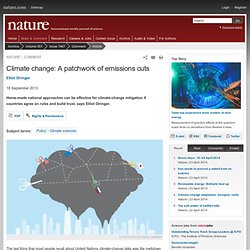
Negotiations have, in fact, continued, and governments have set another deadline: a new global climate agreement in 2015. With this latest round of talks nearing its midpoint, hints of a way forward are beginning to emerge. The path that they suggest is at once encouraging and underwhelming. Governments are yet to formally agree on anything. But in discussions earlier this year in Bonn, Germany, they began earnestly exploring a middle way — one neither as rigorous as the fading Kyoto Protocol to the UNFCCC, nor simply do-as-you-please. Having learned hard lessons in Copenhagen, governments are tempering their expectations this time around. Weathering the Storm: Building Business Resilience to Climate Change. Businesses face growing threats from extreme weather and climate change: damage to facilities, loss of water or power supplies, higher costs, and disruption of supply and distribution chains.
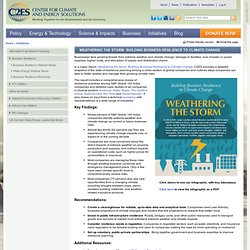
In a major report, Weathering the Storm: Building Business Resilience to Climate Change, C2ES provides a detailed snapshot of the state of resilience planning among a cross-section of global companies and outlines steps companies can take to better assess and manage their growing climate risks. The report includes a comprehensive review of resilience practices among S&P Global 100 Index companies and detailed case studies of six companies in diverse sectors: American Water, Bayer, The Hartford Group, National Grid, Rio Tinto and Weyerhaeuser. It also draws on input from a technical workshop with representatives of a wide range of industries.
Home - Climate CoLab. Policy_series_12-small_Nov_2013.pdf. Addressing the barriers to climate investment. CDKN aims to help decision-makers select and deploy financial instruments – such as grants, concessional loans, equity and guarantees — to fund climate adaptation and mitigation activities.

This guide summarises the barriers to financing mitigation and adaptation activities, as well as discussing factors to consider when selecting and implementing financial instruments. The key financial instruments and modalities considered in this guide are discussed in relation to the Green Climate Fund, but the lessons are applicable to other channels for climate finance. This Guide concludes that understanding barriers related to mitigation and adaptation at the project level is important to identify those projects where investment subsidies will be most efficient. The purpose of the financial instrument needs to be clearly determined. The choice of financial instrument must be reflected in the governance and operations of the GCF and its partners (including national climate finance institutions).
Four Degrees of Global Warming: Australia in a Hot World: Peter Christoff: 9780415824583: Amazon.com. Payments for environmental services and market-based instruments: next of kin or false friends? Working Papers N°14/2013.

Iddri, 2013. 16 p. Un article consacré à la place que tiennent les paiements pour services environnementaux (PSE) dans le champ des instruments de marché pour les services écosystémiques : leur émergence rapide s'est accompagnée d'une certaine diversification, aussi bien dans leur nature que dans les méthodes d'analyse de leurs impacts. Points clés [en anglais] : The emergence of market-based instruments (MBIs) in the field of ecosystem services has been spectacular but still lacks a clear conceptualization. Building Sustainable Legacies Issue 1. Building Sustainable Legacies Issue 1. Payments for environmental services and market-based instruments: next of kin or false friends? Ren21 Map. CCXG EstablishingandUnderstanding_ final full docOct2013. Lcfc_73_wp5_11_v1_scenarios_action_wuxi.pdf. Munich Climate-Insurance Initiative. World Agroforestry Centre. Chapter 8 Tool 1: The Village Map This tool is used when there are no maps of the village available or if you want to redraw an existing one in order to be better understand the village.
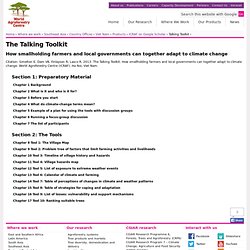
The purpose of the Base Map tool is to produce a common point of reference for participants and the facilitator. For example, it can be used for pointing out the location of common natural hazards (see Tool 3 and Tool 4). This map will form the basis for risk mapping, the participatory scenarios and land-use plans. read more Chapter 9 Tool 2: Problem tree of factors that limit farming activities and livelihoods. Going beyond two degrees? The risks and opportunities of alternative options - Climate Policy - Volume 13, Issue 6. Since the mid-1990s, the aim of keeping climate change within 2 °C has become firmly entrenched in policy discourses. In the past few years, the likelihood of achieving it has been increasingly called into question. The debate around what to do with a target that seems less and less achievable is, however, only just beginning.
As the UN commences a two-year review of the 2 °C target, this article moves beyond the somewhat binary debates about whether or not it should or will be met, in order to analyse more fully some of the alternative options that have been identified but not fully explored in the existing literature. For the first time, uncertainties, risks, and opportunities associated with four such options are identified and synthesized from the literature. The analysis finds that the significant risks and uncertainties associated with some options may encourage decision makers to recommit to the 2 °C target as the least unattractive course of action.
Paristoministerio > Kestävä kehitys. Megacities and the Coast: Risk, Resilience and Transformation. Tekes. Miltä sinun tulevaisuutesi näyttää? How to cook up a Covenant Club? - Networking the Covenant of Mayors. Publications. Research Priorities on Vulnerability, Impacts and Adaptation: Responding to the Climate Change Challenge To respond to the demand for better coordination of research, PROVIA has led the development of a set of Research Priorities on vulnerability, impacts and adaptation in consultation with both experts and policy makers. The Research Priorities include new and emerging topics, and topics that have long been recognized as important but for which research is still required. Click here to download. Improving Nordic policymaking by dispelling myths on sustainable consumption. As Nordic countries have an ambition to be sustainability leaders, enabling sustainable consumption and lifestyles with efficient policies is an important part of reaching this goal. Research demonstrates that evidence from behavioural and social science is not routinely incorporated into policy design.
Consequently, some persistent misconceptions – myths –about consumer behaviour have perpetuated in the mainstream discourse, especially in policy circles. The goal of this study is to dispel myths that thwart sustainability by bringing forward existing evidence on consumer behaviour to aid the development of efficient policies in Nordic countries. A meta-analysis of the existing international research on consumer behaviour from psychology, sociology, behavioural economics, policy and anthropology was conducted.
The results demonstrate that it is unrealistic to expect a sustainable society to materialise from current political strate gies. A Good Life in a Sustainable Nordic Region. A cookie is a small text file, which is placed on your computer or other device. It makes it possible for us to recognize your computer and gather information about which pages and functions are visited with your computer. Cookies contain only anonymous information. Cookies are used by most websites and are in many cases essential for the website to work properly. Cookies on this website We use cookies on this website for various purposes related to functionality, web analysis and marketing.
You can read more about the cookies we use under the three tabs. A Good Life in a Sustainable Nordic Region. Indicators for sustainable development. A cookie is a small text file, which is placed on your computer or other device. It makes it possible for us to recognize your computer and gather information about which pages and functions are visited with your computer. Cookies contain only anonymous information. Cookies are used by most websites and are in many cases essential for the website to work properly.
Cookies on this website We use cookies on this website for various purposes related to functionality, web analysis and marketing. You can read more about the cookies we use under the three tabs. No to cookies If you wish to decline the use of cookies now or in the future, you can change the permission in your browser settings. Read more about how you control cookies in your browser on aboutcookies.org What happens if I say no to cookies? If you choose to decline cookies in your browser, your device will not be tracked when you browse the internet. Publications. Publications. The_Future_We_Want_-_The_Legal_Outcomes_of_Rio__20.pdf. A Climate Vision for Russia: From Rhetoric to Action - RussiaClimate.pdf.
Climate Change Finance: If You Can't Measure It, You Can't Manage It. Climate Change Finance: If You Can't Measure It, You Can't Manage It By Christa S. ClappFNI Climate Policy Perspectives 7November 2012 Climate change finance is currently estimated at between approximately USD 70 and 120 billion per year. However, these estimates involve a fair amount of uncertainty. There is no agreed definition of what climate finance includes; moreover, for private sector flows, the range is estimated using mismatched data sources. The significant sums of financing committed in the international climate change negotiations (USD 100 billion per year by 2020) are expected to be earmarked according to the traditional template whereby developed countries provide financing to developing countries. Managing limited financial resources effectively requires grasping how financial flows contribute to results in climate mitigation and adaptation.
We need a common definition of what types of flows are to be considered 'climate change finance'. Download report > Circle /Uncertainties in decision-making processes: Will guidelines help do the trick? Climate change. Association of Climate Change Officers - Knowledge Center. Knowledge Center Note: Full versions of the following materials are available for a limited time only. Untitled. Clim-ATIC home page. Ympäristökasvatus Keski-Suomessa - Ilmastonmuutos. Varsinais-Suomen energiastrategia 2020. GRaBS - Adaptation for urban areas. During the course of the GRaBS project, partners have been working with the University of Manchester to develop an innovative, cost effective and user-friendly risk and vulnerability assessment tool, to aid the strategic planning of climate change adaptation responses.
The Assessment Tool has an important role to play in the preparation of Adaptation Action Plans, with a particular focus on flooding and heat stress. The Tool assesses the vulnerability of urban areas to climate change impacts, with an additional assessment of relative patterns of spatial risk where suitable data is available. NI 188 Guidance. You may have found us by using the following keywords: Our Climate, Climate Change Partnership, Climate Change, Regional, Adaptation Sub-Group, Adaptation, Local Authorities, Strategy and Monitoring, Built Environment, Transport, Health Services, Business, Land Management, Citizen Engagement, Energy, Waste, Water, Carbon, Flood risk, Mitigation, Leadership, Low Carbon Products, Low Carbon Services, Zero Carbon, Integrated Regional Strategy, Yorkshire and Humber Strategy, Climate Change Act, Regional Adaptation Study, Climate Change Plan for Yorkshire and Humber, Climate UK, Regional Coordinator, Low Carbon Economy, Bio-mass, Carbon Capture, Microgeneration, Local Area Climate Change Network, YoHr Space, Climate Change Board, Impacts, Vulnerability, Opportunities, CO2, NI188, NI186, NI185, NI187, Temperature, Rainfall, Extreme weather.
How vulnerable could your city be to climate impacts? Climate change is expected to increase the frequency and intensity of river floods and extreme temperature events in many parts of Europe. If heavy rain caused rivers to rise by one metre, which European cities could be most at risk from flooding? Which cities could provide relief during heat waves with large green areas and which city designs could most exacerbate the effect of heat waves? What are the capacities of different European cities to cope with climate change impacts and to adapt to future changes? IPCC. Making cities resilient report 2012. Suburban Climate Change Efforts: Possibilities for Small and Nimble Cities Participating in State, Regional, National, and International Networks by Hari Osofsky. The RTCC Climate Change A-Z.
Designing public sector interventions to mobilise private participation in low carbon development: 20 questions toolkit. Manual_Governance_EN_FINAL.pdf (application/pdf-tiedosto) Manual_Observatories_EN_FINAL.pdf (application/pdf-tiedosto) Key issues on climate change. Localmanagement.eu introduction - CHAMP Local Response to Climate Change. N kaupunki - Julkaisut ja raportit. Guidebook_CLimateChange.pdf (application/pdf-tiedosto) (application/pdf-tiedosto) 16507IIED: ISO 26000 and global governance for sustainable development. UK Climate Change Risk Assessment. Executive-Report-Policy.pdf (application/pdf-tiedosto) HUB_LearningToTackleCC_Hi.pdf (application/pdf-tiedosto)
‘Inclusive green growth’ – a review. Enhancing Capacity for Greening Development. Mitigation. Rio+20 UN Conference on Sustainable Development. Governing Climate Engineering: Scenarios for Analysis by Daniel Bodansky. Hotting Up? An Analysis of Low Carbon Plans and Strategies for UK Cities.